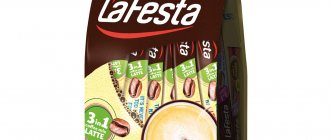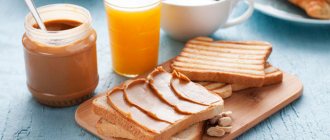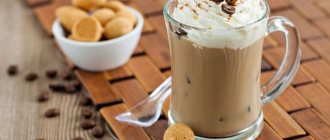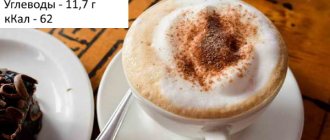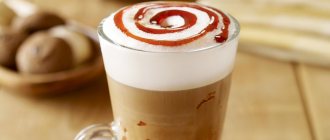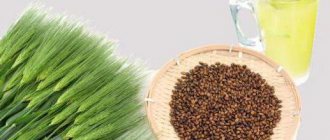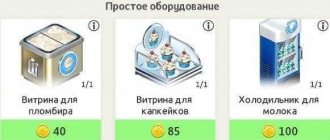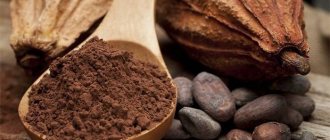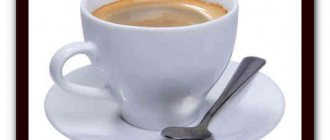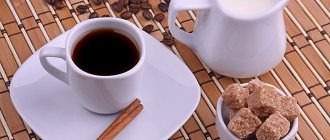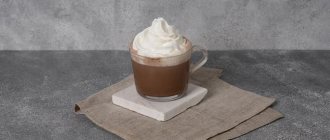Doctors and scientists have been arguing about the benefits and harms of coffee for decades. Regardless of the outcome of these discussions, the number of admirers of this tasty and aromatic drink is not decreasing. When consuming a product, people traditionally pay attention to its properties. Those watching their figure should also take into account the calorie content of coffee, which depends on many factors.
Coffee is a strong tonic drink.
Brief characteristics of coffee
There are many myths surrounding the drink. The result of numerous scientific studies devoted to its properties often leads to opposite conclusions.
Beneficial features
Major medical studies conducted over the past decade point to coffee's ability to reduce the risk of developing diseases such as coronary heart disease and heart failure. The substances contained in its grain have a tonic effect on the heart and blood vessels. We are talking about moderate consumption of natural coffee.
The drink improves glucose metabolism and insulin secretion. This allows us to consider the product as a means of preventing diabetes.
According to some researchers, caffeine maintains a person’s cognitive abilities at a high level and helps reduce the risk of developing Alzheimer’s disease. Reasonable consumption of an aromatic drink has a positive effect on mental health and mood due to its effect on the activity of serotonin and dopamine, the hormones of happiness and pleasure. The positive effect of its use can be considered long-term, since the product has an antioxidant and anti-inflammatory effect on the body.
BZHU and chemical composition
The biological value of coffee is assessed taking into account the nutrients it contains. Raw grains are rich in non-synthesized amino acids, proteins, and fats. The product collected from the tree contains more than 60% carbohydrates (polysaccharides and fiber), but during the process of roasting the beans, they are transformed into substances that form the taste of coffee and its aroma, without affecting the calorie content of the drink. Fats account for from 9.4 to 18%, proteins account for from 9 to 19%.
The chemical composition of coffee includes caffeine and tannins.
The chemical composition of coffee should also include:
- tannins - organic substances that give the product astringency and bitterness;
- trigonelline is an alkaloid responsible for the taste and aroma of the drink;
- chlorogenic acid - a substance due to which the product acquires astringency;
- caffeine is an alkaloid that has no taste or odor, but has an effect on the central nervous system.
The last of these components was originally obtained from coffee beans, which led to its name. The tonic effect, increased mental and physical performance - these are the properties of the drink, which it owes exclusively to caffeine.
In accordance with modern requirements, the product must contain at least 0.7% of this alkaloid. This figure depends on the degree of maturity of the grains and the technology for their subsequent roasting. If the indicator is met, 1 tsp. freshly ground coffee contains up to 0.2 g of alkaloid. This is enough to get the promised tonic effect, which will last up to 4 hours.
Repeated consumption of coffee during this period is not recommended, otherwise the positive effect will be transformed into a negative one.
A person will experience sleep disturbances, increased excitability, and rapid heartbeat.
Harm and contraindications for use
The beneficial properties of coffee drinks appear with moderate consumption. Regular intake of more than 1000 mg of caffeine leads to the formation of addiction, similar to alcohol or drugs.
The drink is contraindicated during pregnancy.
In some cases, coffee consumption should be controlled, and in some diseases and conditions the drink is completely contraindicated:
- Pregnancy and breastfeeding. The caffeine contained in the product penetrates the fetoplacental barrier and can cause pathologies or even fetal death. The expectant mother should refrain from drinking coffee. Doctors give the same recommendation to nursing women: the alkaloid passes into breast milk and negatively affects all vital systems of the baby.
- Childhood. Caffeine can cause delays in the growth and development of a child and provoke the occurrence of cardiovascular pathologies. The age at which children can drink coffee is 13-15 years.
- Sleep disturbance in any form. Drinking the drink stimulates the activity of all systems of the human body and increases alertness. The effects of caffeine last for several hours.
- Mental disorders (various forms of neuroses, panic attacks, etc.). If you consume large doses of caffeine, the body produces an excess amount of adrenaline, which increases the manifestations of severe restlessness and anxiety and provokes panic attacks.
- Gastrointestinal diseases: acute and chronic gastritis, peptic ulcer. Coffee is a common cause of gastroesophageal reflux (heartburn). The drink increases the activity of the colon, which can lead to diarrhea. Caffeine destroys the protective barrier on the gastric mucosa and increases the production of hydrochloric acid and gastrin. This property of the alkaloid can provoke the appearance of erosion and ulcerative defects.
- Hypertension and symptomatic arterial hypertension. Once in the body, caffeine causes a slight increase in blood pressure. A healthy person does not feel this difference, but in people suffering from these diseases, it can provoke the development of a stroke or myocardial infarction.
Is it suitable for those on a diet?
Lovers of the aromatic drink who adhere to a strict diet are interested in how many calories are in a cup of coffee. This product itself is low-calorie: in 1 tsp. powder for making instant coffee contains only 2 kcal, the same amount of ground natural coffee (without additives) contains no more than 20. These figures can be safely neglected when calculating the daily diet.
The advantage of the product is its diuretic effect. In addition, caffeine speeds up metabolism: when it is present, the body burns fat faster.
Coffee is a low-calorie drink.
However, a low calorie content is typical only for a drink without sugar and other additives. Coffee of various types in combination with cream, sugar, chocolate and syrups can no longer be called dietary. These supplements contain a lot of fats and carbohydrates, the nutritional value of which cannot be ignored. If a serving of Americano with sweetener does not harm your figure, then daily consumption of 250 ml of Viennese coffee with milk, cream and a spoon of honey cannot be called a healthy habit.
You can reduce the calorie content of a flavored drink with additives if you prepare it yourself using the following ingredients:
- milk with fat content no more than 1%;
- sugar substitutes (stevia, agave syrup);
- spices that reveal and complement the taste (cinnamon, vanilla, cardamom, nutmeg).
An alternative to classic coffee can be matcha latte. This is a traditional Japanese green tea powder, supplemented with frothed milk. In addition to caffeine, the drink contains L-theanine, which slows down the absorption of the alkaloid and allows you to prolong the effect of vigor. To prepare a matcha latte, take 3 g of tea powder, whisk it in hot water to form a thick paste and add foam from the hot milk. The calorie content of 100 g of drink does not exceed 40 kcal.
Norm per day
The list of positive qualities of the drink is long, but excess caffeine has a negative effect on the body, negating all the advantages of the product and provoking the development of dangerous diseases. You need to drink coffee in quantities that are not harmful to your health.
There are 3 main varieties of beans: Robusta, Arabica and Liberica. The first has a rich, strong taste and bright aroma. Arabica is softer, with a less pronounced coffee smell. Liberica is rare and is characterized by a specific aroma, low strength and unsaturated taste.
The permissible volume of the drink depends on the amount of caffeine in it.
The amount of caffeine in different types of beans varies. Most of it is in Robusta, 30% less in Arabica. Accordingly, the permissible amount of a drink made from beans of one type or another will be different: the daily intake of coffee made from 100% Arabica coffee may be higher.
For a healthy person, the optimal dose is 300 mg of caffeine per day and no more than 150 mg of the alkaloid at a time. This is equivalent to 2-3 cups of drink.
A serving of espresso contains up to 135 mg of caffeine, cappuccino - up to 80 mg. The minimum concentration of the alkaloid in decaffeinated types of drink is about 4 mg. However, you should not consume such a product in large quantities.
Due to repeated chemical processing aimed at extracting the alkaloid, the drink loses its beneficial properties and invigorating effect.
Factors and substances affecting calorie content
Roasted coffee beans lose some of their weight and gases appear inside the beans. Depending on the degree of frying, the weight will be more or less. The grains acquire a unique aroma. Their calorie content is 223 kcal per 100 grams.
The degree of roasting has almost no effect on the calorie content of coffee. Due to the almost complete evaporation of the fats contained in it, beans with a higher degree of roasting have fewer calories. Also, the higher the degree of roasting, the more intense the taste and aroma of the drink.
The degree of roasting of the beans has virtually no effect on the calorie content of coffee
Freshly ground coffee has a more pronounced taste and aroma than long-ground coffee. This happens due to the fact that as a result of the destruction of the grain, evaporating substances react with air and partially evaporate. Calorie content does not change depending on how long it has been roasted.
The most high-calorie drink will be the one that contains the least amount of water. Since coffee beans contain monosaccharides, including glucose and fructose, the longer the contact with water, the more caloric the drink will be.
Coffee calorie information
The caloric content, or energy value, of coffee beans, the product ground into powder, and granules for preparing an instant drink differ. 100 g of roasted beans contains from 223 to 331 kcal. The ground product has a lower energy value - about 200 units. energy. The powder for preparing the drink is even lower in calories - no more than 120 kcal per 100 g.
Table of instant coffee manufacturers
Different brands of products contain different nutritional values. The values are shown in the table:
| Coffee brand | Calorie content, kcal/100 g |
| Jacobs Monarch | 101 |
| Nescafe Gold Barista | 64 |
| Carte Noire | 100 |
| MacCoffee 3 in 1 | 420 |
The calorie content of a drink with additives (sugar, vegetable cream) is several times higher than that of instant black coffee.
Material on the topic: “Coffee with milk without sugar - calorie content of instant and natural coffee”
Are there differences between granulated and powdered coffee?
Natural beans are used as raw materials for the production of all types of instant coffee. At the first stage, the process proceeds in the same way: the plant material is fried, ground, poured with hot water and boiled for several hours.
Granulated coffee is a soluble powder that is pressed into small granules using steam.
To make freeze-dried coffee, the brewed coffee mixture is placed in a flash freezer. Moisture is removed from the resulting crystals in a vacuum chamber. The result of processing is a compacted dry mass with a light brown color. It is crushed into granules, coffee oils and flavorings are added.
To obtain powdered coffee, the concentrate is dried under high pressure, resulting in it turning into a powdery mass.
Consumers often perceive a granulated drink as richer. Additional taste and aroma are given to it by oils and extracts that are added to the finished product. However, they have nothing to do with the aroma and astringency of natural grains.
The caffeine content in both granular and powdered products is the same: from 60 to 100 mg per 150 ml of coffee.
This is 15-20% lower than in a drink made from ground grains.
Drink 3 in 1
Ready-to-drink 3-in-1 coffee in individual packaging is convenient to take with you. To prepare it you only need boiling water. In terms of taste and benefits, the drink cannot be compared with custard, but many people choose the speed of preparation and are ready to sacrifice the aroma and astringency of the natural product.
3 in 1 drink - ready-to-drink coffee.
Most of the concentrate is sugar and vegetable fats (palm, coconut oils), replacing dairy components. In addition, in the list of ingredients you can see flavor enhancers, components that prevent caking of the powder mass, citric acid, and emulsifiers. The content of coffee itself in such a bag rarely exceeds 15-20%.
In the first place in the list of ingredients is sugar, which, in combination with fats, increases the calorie content of 100 g of concentrate for preparing a 3 in 1 drink to 350-450 units. It contains up to 70 g of carbohydrates, about 10 g of fats, and no more than 2.5 g of proteins. There are about 80 kilocalories in 1 sachet, calculated for a glass of ready-made coffee.
Does variety affect energy value?
Coffee varieties grown on different continents have different BJU, composition and nutritional properties. This is due to the conditions for growing grains and the specifics of the variety itself. However, these differences will be small and will have little effect on the nutritional properties of a cup of drink.
So, a coffee with milk without sugar, made from mocha beans collected in Ethiopia, will have the same calorie content as a drink brewed from Colombian Excelso.
In both cases, the most nutritious component of the product will be milk.
Calorie content of ground coffee beans by preparation method
The energy value of the product required to prepare a drink in a coffee machine or Turk is determined by the amount of powder. According to experts from the Italian Coffee Institute, for a cup of espresso (30 ml) you need to take 7-8 g of ground coffee in order to maintain its 1:4 proportion with water.
The energy value is determined by the amount of powder.
A boiled product requires a different ratio of ingredients. To prepare Turkish coffee, take 15-20 g of powder to get 200 ml of drink. The classic proportion here is 1:10. Accordingly, there will be more kilocalories in a cup of brewed coffee - about 15. However, the serving size cannot be compared with the volume of the drink brewed in a coffee machine (30 ml), which contains a minimum of calories.
By type of coffee
There are many options for preparing the product.
Depending on the additives that shape the taste of coffee, the final product turns out to be dietary or, conversely, too nutritious:
- Espresso. The lowest calorie type of coffee: 1 serving without additives contains about 4 kcal. It is customary to drink this strong drink “pure”, but if you put a spoonful of sugar in a cup, its calorie content will increase to 25-30 units.
- Americano. To prepare this type of coffee, take the same amount of powder as in the previous recipe, but add more water to it. The energy value of a serving (150 ml) is the same 4 kcal.
- Latte. In a popular Italian coffee recipe, double espresso is topped with a lot of steamed milk. A latte without sugar (220 ml) contains from 180 to 220 kcal, depending on the fat content of the milk. If you enrich the taste of the drink with sugar, syrup, grated chocolate, and ground nuts, this figure will be above 250.
- Raf coffee. The cocktail is made from espresso, cream, vanilla and sugar. This sweet product contains about 200 units. energy.
- Moccaccino. The drink with a bright chocolate flavor contains strong coffee, milk and chocolate (chocolate syrup). The nutritional value of the product depends on the chocolate used in its preparation. On average it is 250 kcal and can increase if the cup is decorated with whipped cream when serving.
- Cappuccino with almond milk. Drink lovers who do not consume dairy products often replace the animal product with a plant-based analogue. 300 ml of this coffee contains more kilocalories than a traditional cappuccino with cow's milk - more than 300.
- Irish coffee. The classic recipe contains espresso, whiskey, cream and sugar. A serving of this low-alcohol coffee cocktail contains about 250 kcal.
Espresso is a type of coffee prepared by running hot water.
Energy value of a cup of coffee with additives
A brewed drink without sugar, cream, or other additional ingredients can be called dietary. But many admirers of the product do not use it in its pure form. The calorie content of coffee with milk and sugar increases several dozen times when compared with the originally prepared drink.
The most popular additive is sugar. Each teaspoon of sweetener contains 20-25 kcal, so a cup of Americano with 2 spoons of sugar contains not 4, but 54 kcal.
The traditional accompaniment of coffee is milk of varying fat content or cream. Often it is replaced with a plant product and cappuccino is prepared with coconut milk. This analogue cannot be called low-calorie. If you pour 100 ml of milk with a fat content of 2.5% into a cup of espresso, the calorie content of the product will be 56 kcal. A drink with 50 ml of 10% fat cream will contain 63 units. energy. The nutritional value of 0.1 liter of coconut milk is 229 kcal.
Syrups are a popular addition to milk drinks. They invariably contain large amounts of sugar.
Adding 10 ml of chocolate syrup to a glass of latte (220 ml) increases the energy value of your favorite drink to 250 kcal.
Calorie table for popular coffee drinks
So, each type of coffee has its own calorie content, which is determined by its composition and the presence of additives. The table below will help you estimate the calorie content of the most popular coffee drinks.
| Name of coffee | Volume, gram | Calorie content, kcal |
| Natural coffee | 100 | 1-2 |
| Ground coffee | 200 | 4 |
| Instant coffee | 200 | 14 |
| Americano | 450 | 15 |
| Latte | 450 | 250 |
| Cappuccino | 150 | 210 |
| Moccaccino | 450 | 290 |
| Glasse | 450 | 125 |
| Frappuccino | 450 | 400 |
| Coffee 3 in 1 | 200 | 70 |
| Rough coffee | 150 | 135 |
So, coffee is a low-calorie drink. However, various coffee drinks have a higher calorie content due to the presence of more high-calorie ingredients in their composition. This should be kept in mind by those who are watching their figure. However, always remember that the joy of your favorite drink is much more important than carefully counted calories.
How to calculate calorie content if there are a lot of additives
Few coffee lovers drink it in its pure form. If there are a lot of additives, several cups of your favorite drink a day can be as dangerous for your figure as buns, chocolates or sausages.
Assess the nutritional value of ingredients added to coffee.
To determine the final calorie content of a cup of coffee (in the original product it is close to zero), you need to evaluate the nutritional value of the ingredients added to it and add up the resulting numbers. So, 3 tsp. sugar adds 75 kcal to the drink, 100 ml of skim milk - another 30. 50 g of creamy ice cream, which successfully highlights the taste of coffee, contains more than 100 kcal.
If you add up the energy value of all the above additives, a serving of double espresso with skim milk, 3 tablespoons of sugar and a scoop of ice cream will contain about 220 kcal.
Calorie content of coffee served in restaurants and fast food chains
An excellent end to lunch or dinner in a cafe is a cup of coffee. Modern fast food chains offer it in a wide range. At Costa Coffee you can try not only traditional espresso, but also a stronger version of the drink without additives - ristretto, containing only 20 ml of water. The nutritional value of both is 4 kcal.
At Coffee House you can order a large glass (470 ml) of aromatic drink with milk. It will contain 207 units. energy. At the visitor's request, a latte with syrup is also prepared - the calorie content of the product in this case will be even greater.
The Cofix coffee chain offers a latte with caramel syrup. 100 g of this product contains 90 kcal.
A serving of KFS cappuccino (300 ml) contains 147 units. energy.
However, the leader in nutrient content is the refreshing coffee drink Frappuccino, popular in establishments in Europe and America. A mixture of strong coffee, milk, sweet syrup and ice is served in a large glass (500 ml). This serving contains 43 g of carbohydrates, 10 g of protein and fat. The nutritional value of the dessert is almost 300 kcal.
The influence of the presence of flavors and spices
The presence of flavors and spices improves the taste and aroma of coffee, but at the same time increases its calorie content. Flavorings often contain sugar and fat. Accordingly, calorie content can double.
Among the herbs and spices that are added to coffee, the most popular are cinnamon, vanilla, allspice, cumin, star anise, cloves, and turmeric. In addition to taste, spices, unlike flavorings, make the drink healthier. Depending on the amount of spices added, the number of calories in coffee increases in proportion to the amount contained in a particular seasoning.
The presence of flavors and spices improves the taste and aroma of coffee, but at the same time increases its calorie content
A natural drink without sugar and without additives is not only good for human health, but also does not significantly increase the amount of calories consumed.
Espresso has the lowest calorie content.
Due to the content of artificial additives, instant coffee not only has a harmful effect on the human body, but also, with unlimited consumption, can significantly increase the average daily caloric content of consumed substances. Spices and herbs added to coffee, along with a slight increase in calories, increase the body's ability to burn fat.
What is the lowest calorie coffee?
Black coffee is a diet drink. Its popular variants are espresso, Americano and ristretto. The calorie content of a cup of any of them is only 4 kcal. Per 100 grams of prepared instant drink there is no more than 2 kcal. This is true for any version of the product without any additives. The latter greatly influence the nutritional value of the product. With the addition of sugar, milk or cream to a mug, the amount of fats and carbohydrates in the product increases rapidly. This drink is no longer low-calorie.
Recommendations for those who watch their figure
Those who count calories and control their own weight do not necessarily have to exclude the morning ritual in the form of a cup of invigorating espresso or Americano. It is enough to follow simple rules, and then your favorite drink will not interfere with weight loss:
- You can't drink coffee on an empty stomach. This negatively affects the functioning of the gastrointestinal tract and contributes to excess weight gain.
- Only natural coffee brings benefits. The soluble product contains chemicals that negatively affect the body.
- You should observe the measure and not abuse the quantity: 1-2 cups of espresso or Americano per day is quite enough.
- Green grains contain more antioxidants than roasted ones, which helps speed up your metabolism and help you shed extra pounds.
- For those watching their weight, it is advisable to drink natural espresso or Americano without sweeteners or calorie additives. You can also use ground cinnamon, ginger, lemon. You are allowed to pour in a little low-fat milk.
